Pain is a universal phenomenon. It is an unpleasant sensation felt by more than half of the world's population. Pain is a real perception and leads to considerable deterioration of quality of life in patients with arthritis and other rheumatological conditions. It has complex causes and is a leading cause of morbidity. Pain limits the ability to perform day-to-day activities, maintain social relationships and lead a productive life. 'Pain is a perfect misery, the worst of evils, and when excessive, overturns all patience' (John Milton).
Pain is a sensation that starts from sensors in the skin and other organs and reaches the brain via nerve fibers passing through the spinal cord. It can be nociceptive (produced by injury), neuropathic (due to irritation of nerve), mixed or psychological. Fast pain occurs after an injury. Localization of this protective pain is sharp and accurate. Slow pain is a delayed perception after tissue injury that helps in healing. Descending chemical and electrical impulses from the brain modulate pain perception to a significant extent.
Pain may be described in various ways: sharp, shooting, burning, nagging, dull, and aching. It is challenging to quantify pain as it is a subjective sensation. Back pain can be as severe as cancer pain, whereas arthritis pain can be almost half of pain during childbirth. The severity of pain is generally measured by visual analog or numerical rating scales, which ask the patients to rate the severity of their pain on a 1-10 or 1-100 scale. Pain leads to restlessness, anxiety, and depression. Physical effects of pain include nausea, vomiting, palpitations, urinary incontinence, rise in blood pressure, etc.
Pain does need treatment, but it must be realized that pain is a protective phenomenon. Pain in arthritis limits movements that can be damaging. Chemical substances released during slow pain help in healing.
One must learn to bear and live with at least some arthritis pain. We have many effective drugs for pain relief, but not all work in patients in an identical way. Though invaluable in pain management, they are notorious for causing skin rashes, acidity, and other more severe abdominal problems, liver and kidney toxicity, as well as effects on heart and blood pressure. In addition, they interact with some other drugs, such as those used for diabetes and blood pressure. Control of the causative disease, e.g., rheumatoid arthritis, alleviates the need for pain medication.
Guidelines by the European League against Rheumatism (EULAR) on the use of pain killers include the following:
- Avoid long term use
- Use as and when required and not continuously
- Use the lowest effective dose for the shortest duration
- Use only one painkiller at a time
- Avoid them in stomach ulcer and kidney disease
Prescription of painkillers must be individualized after assessment of need and risk factors. Paracetamol (maximum dose: 4 grams/day) is a comparatively safe painkiller. Local application of heat or ice pack or an ointment should also be tried in all cases of musculoskeletal pain. Patient education regarding self-help, social support, joint protection, assistive devices, physical therapy and exercise, acupuncture, and music therapy are important non-drug measures in pain management.
